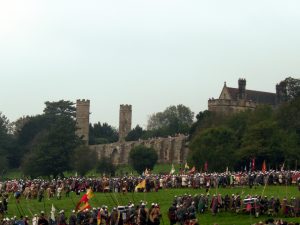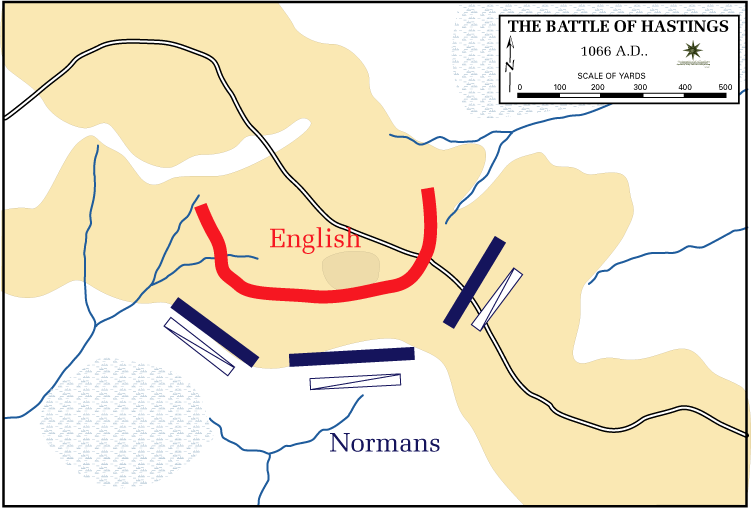
PHOTO: wga.hu
It’s a battle that’s recorded in history textbooks all over the globe, and one of the most decisive battles ever in European history. It began on a sunny, cold day in October of 1066, lasting from 9AM until dusk.
The battle was fought between William the Conqueror and Harold Godwine, and had the outcome been different, the England we know today would not exist.
The Death of Edward the Confessor
It all began as a dispute between four kings as to who held the rights to the English throne. See, at the time, England was ruled by Saxon King, Edward the Confessor. The Saxons were English-born descendants of Viking raiders who settled England in the late 900s and early 1000s AD. Now, our man King Edward was connected to both the Saxons, and to the Normans in the area of what is modern-day France, through his his mother, Emma, the sister of Richard II, Duke of Normandy. Edward ended up producing no heirs to his throne, and so when he died on January 5th, 1066, there was a succession crisis in England. By law, the throne should pass to the Earl of Wessex: Harold Godwinson. He was the richest and most powerful of all of the Saxon aristocrats. Harold was even elected king of England by the Archbishop of York.
This was immediately disputed by three men: Harold’s exiled brother, Tostig Godwinson, Harald III of Norway, who believed he had been promised the throne by the previous King of England, and Duke William of Normandy, who said that Edward the Confessor had agreed before his death in a private conference that he was to be named Edward’s heir.
The Mounting Conflict

PHOTO: wikimedia
While the latter hung back in France, secretly preparing his forces for an assault on England, Tostig and Harald III, also known as Harald Hardrada, mounted their own invasions on England. Harold Godwinson’s brother, Tostig, launched a raid on south-eastern England, but he was driven back to his ships and withdrew to Scotland.
Hardrada invaded northern England in early September, leading a fleet 300 ships strong with about 15,000 men. They advanced on York and captured the city.
Harold, King of England, had been sitting on the south coast of England with his army, expecting William to invade. When he heard of the Norwegian invasion he rushed north, took the Norwegians by surprise, and defeated them. Both Harald of Norway and Harold’s brother, Tostig (who had joined the Norwegian king after his own defeat), were killed.
The English had their victory, but it came with a huge cost: Harold III’s army was left in shreds.
In April of 1066, Halley’s Comet appeared in the sky, red and flaming, and word of it spread throughout Europe. Contemporary accounts said that the comet was connected with the succession crisis in England.
It was then that William of Normandy saw his chance.
The Battle
William of Normandy spent the next few months gathering his forces while Harold sat in northern England, at York. The Norman duke crossed the English Channel in September of 1066 and landed at Pevensey. The army raided the surrounding area, and set up camp at Hastings, close to the nearby present-day town of Battle, East Sussex.
The minute Harold heard that William had landed in England, he panicked and moved south from York.
Many of the primary accounts that detail the Battle of Hastings contradict each other, so it’s impossible to give a description of the battle that is beyond dispute. However, all the accounts agree on one thing: the fighting began at 9AM, on Saturday, October 1066, and the battle lasted until sundown.
The battle took place between two hills: Caldbec Hill to the north, and Telham Hill to the south. The area was forested and marshy, making it difficult for both armies to move.

PHOTO: wikimedia
Not much is known for sure about the actual battle tactics. But what we do know is that William arranged his army into three groups, surrounding the English on three sides in a “U” shape. The middle was held by the Normans, the sides were held by Bretons. Archers and foot soldiers held the front lines, and the cavalry was held in reserve.
The English met them with a shield wall, anchored to a nearby stream, their flanks protected by woods and the marshy ground in front of them.
The two sides met, and the battle was opened with the whistling of arrows through the air from the Norman side. William sent his spearmen forward, but they were met with fierce resistance and couldn’t punch a hole in the shield wall, so the cavalry was sent in. They, too, failed, and when a rumor was started that William was dead, the Normans began a retreat.
The English broke their ranks into pursuit. They were met with William riding through his own forces, showing his face, yelling that he was still alive. His forces rallied to him, turned around, and overwhelmed the English on the hill. But it wasn’t a victory for the Normans, not yet.
Victory and Outcome
![The battlefield of Hastings [PHOTO: wikimedia]](https://historythings.com/wp-content/uploads/2016/06/1024px-Schlachtfeld_Schlacht_bei_Hastings_juni09-1024x768.jpg)
The battlefield of Hastings [PHOTO: wikimedia]
So, feign retreat William did, twice.
It worked. The English broke ranks and pursued the retreating Normans, and were routed both times. Harold was killed in combat, and his body later identified. Leaderless, the English fell into chaos, and William of Normandy easily took the victory.
William of Normandy was crowned rightful king of England on December 25th of 1066 in Westminster Abbey. Though the English nobility surrendered, resistance to the Norman crown would continue to erupt for years after.
William of Normandy put his own nobles in charge of England, which created a cultural rift between the upper and lower classes in Britain. The Normans brought their culture and their language, which was responsible for the cultural revolution in England in the 1100s. If the battle had gone differently, England would be unrecognizable.
The Battle of Hastings was dramatized on the famous Bayeux Tapestry, which can be viewed in its entirety online, here.

